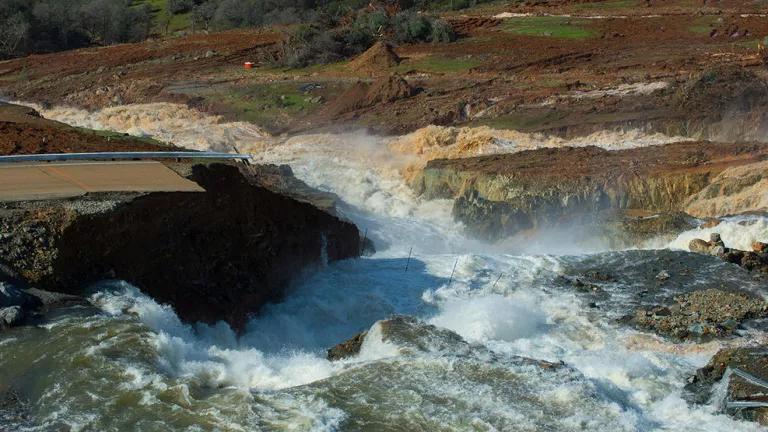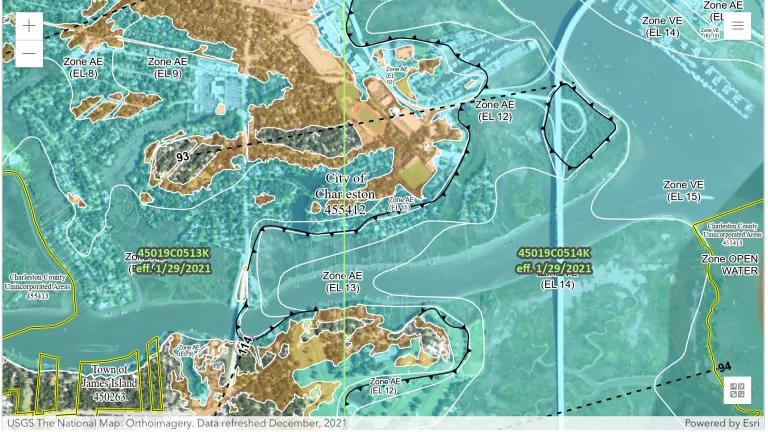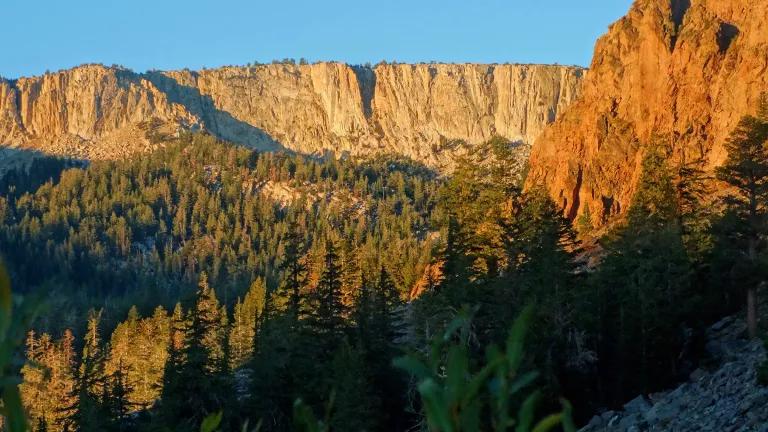What Can Happen When NEPA Is Ignored: The Oroville Dam

Justin McCarthy of the Partnership Project is a co-author of this Case Study.
The Oroville Dam Case Study is a good example of the harm that can be caused when courts, agencies, and developers fail to take the National Environmental Policy Act (NEPA) seriously.
A Short Background on the Historic Roots of NEPA
Passed into law with an overwhelming bipartisan majority in Congress and signed by President Nixon on January 1, 1970, the National Environmental Policy Act is often characterized as an environmental impact review law, and it is that—but it is much more than that. It is a law that has made informed decision-making about the environment a key component of every major federal action.
Although the passage of NEPA is often directly attributed to the devastating 1969 Santa Barbara blowout and oil spill, that overly simplistic explanation obscures the law’s far more democratic roots. Its passage was also prompted in reaction to the construction of the Interstate Highway System in the 1950s and 1960s, a process that ripped apart many inner cities and turned existing racial borders into concrete with little regard for those who lived there.
NEPA brought a new level of transparency and accountability to government decision-making. No longer was the federal government allowed to say “we know best” and simply pave over entire communities.
An essential part of this process is NEPA’s mandated public comment period. Before a project is started and throughout its development, the federal government must ask the public—including local communities—to voice concerns. They must also ask for local expertise regarding the project. This is arguably the most important pillar of NEPA; it draws on our democratic values to ensure that projects are undertaken with the benefit of our communities in mind.
California’s Oroville Dam
Nowhere is the importance of ensuring public participation in government decision-making better illustrated than California’s Oroville Dam. Built in the 1960s, the Oroville Dam is the tallest dam in the United States, with a height of 230 meters (750 feet).
Located 75 miles north of Sacramento, the dam holds back a reservoir containing 1.1 trillion gallons of water, supplying farms and cities across the state.
After enduring five years of brutal drought, California went from one extreme to the other—from too little water to too much water. By February 2017, the Oroville Reservoir was operating at 151 percent of normal capacity and still rising.
In order to prevent the dam from overflowing, operators were forced to release the excess water through a process of controlled discharges through the spillway.
There was only one problem. On February 7th, the dam’s main spillway cracked in two, prompting a temporary shutdown of the structure just as another major rainstorm rolled through Northern California. Lake Oroville filled so high that water flowed over the emergency spillway for the first time ever. After another major release of water on February 12th, dam engineers discovered that the spillway’s condition had worsened—erosion on the hillside was compromising the integrity of the entire spillway.
As water began pouring over the top of the “emergency” spillway, a new an even more worrisome dilemma presented itself. The 30-foot-high concrete barrier at the top of the emergency spillway was in danger of failure.
Some 180,000 residents were forced to evacuate, faced with the prospect of 30-foot wall of water headed their way that would flood dozens of towns downstream. It would have been the worst environmental disaster in the history of Northern California.
Disaster was ultimately averted when dam engineers decided the damaged main spillway was still capable of handling larger water releases.
Although residents were eventually told they could return home on February 13th, the evacuation had real consequences. Forced to close their doors for days at a time, small businesses were particularly hard hit. Miner’s Alley—a local Oroville bar—estimated it lost close to $10,000.
The almost-disaster could have been avoided altogether if state and federal officials had heeded the warnings of environmental groups over a decade ago.
In accordance with the Federal Power Act, hydropower projects that are not owned by the federal government undergo relicensing of their facilities every 30 to 50 years, a process that requires completion of a new Environmental Impact Statement (EIS). First licensed back in 1957, the Oroville dam began this relicensing process in December 2000 at the request of the Federal Energy Regulatory Commission (FERC).
In 2003, three environmental groups—Friends of the River, the South Yuba Citizens League, and the Sierra Club—filed a motion with the federal government to make FERC’s renewal of the operating license conditional on lining and reinforcing the dam’s emergency spillway.
“At present, the ungated spillway at Oroville Dam consists of a spillway lip only—and utilizes a hillside as the project spillway,” the groups wrote in 2003 to the Federal Energy Regulatory Commission (FERC). “Utilizing such a spillway has the potential to cause severe damage to the downstream hillside, project facilities and downstream environments located in the path of the flood release.”
The Yuba County Water Agency—which owns transmission lines and other infrastructure in the area—also noted serious concerns in a 2002 memo. “The discharge area below the emergency spillway is not armored, and extensive erosion would take place if the emergency spillway were used,” the memo stated. “The spillway road and possibly high voltage transmission towers would be impacted.”
Unfortunately, the motion to intervene was dismissed and the environmental groups’ comments to FERC’s draft EIS were brushed off by both state and federal agencies. An independent report published in January 2018 suggested that the concerns of environmentalists in 2005 were shaken off in part because the agency was concerned about the costs the improvements would incur.
The city of Oroville filed a lawsuit filed in January 2018 alleging that the crisis at the dam was the result of "decades of mismanagement and intentional lack of maintenance" by the Department of Water Resources and said the agency "buried its head in the sand" after being made aware of problems in the early 2000s.
Ensuring Citizen’s Access to the Courts
As climate change makes extreme weather events like hurricanes more frequent, isolated incidents like the one that occurred at Oroville dam in 2017—made possible by a “perfect storm” of prolonged drought followed by a period of heavy rain—are likely to occur with increasing frequency across the county. In the case of the Oroville dam, disaster was ultimately averted. The next community downstream, however, may not be as lucky.
Over the past four years in Congress, 150 pieces of legislation have been introduced seeking to undermine, weaken, or waive NEPA. Current legislative proposals in Congress, made bolder by the election of Donald Trump, are even more alarming. If passed, the government would be able to rubber stamp permits for corporations to build oil pipelines and toxic waste dumps without any environmental review.
If President Trump and opponents in Congress are successful in their war on NEPA, the ability of local citizens groups like the South Yuba Citizens League and Friends of the River to take the federal government to court and hold federal agencies accountable for dangerous or rushed projects would be severely restricted.
This campaign to eliminate NEPA is based on the demonstrably false claims that NEPA is both a major cause of project delay and a tool for frivolous litigation.
The facts tell a different story. The federal government undertakes 50,000 actions every year subject to NEPA review, but only 500 draft EISs are prepared annually. A Federal Highway Administration study found that from 1998 to 2004, no more than 3.5% percent of all proposed transportation projects required a detailed environmental study.
The volume of litigation under NEPA is also low: fewer than 100 NEPA cases are filed in district court annually, about half of which involve challenges to EISs.
Bulldozing public input and citizen’s access to the courts under NEPA will not speed up infrastructure projects. As the Oroville dam demonstrates, gutting NEPA will only result in the construction of major infrastructure projects like bridges and dams without full consideration of the long-term impacts on people and ecological environments.
Any law that provides broad opportunities for public participation in government decisions that affect the environment and local communities shouldn’t be rolled back, it should be embraced. Rather than weakening NEPA—a law that is essential to ensuring government transparency and accountability—Congress should provide additional funding for full-time technical staff at the state and federal levels to ensure timely completion of environmental review.
- “The emergency spillway remained basically a dirt, soil rock facility, and it worked fine until it had to be used, in which case it didn’t work so well,” said Rep. John Garamendi, whose constituents included 150,000 of the evacuees.
- “When I think about the fact that the (auxiliary) spillway at Oroville did not even have concrete lining on it, I’m just really surprised,” said Rep. Doris Matsui. “I would think that would be the first thing you could do.”
- “Some hard questions have to be answered about why this facility was apparently neglected in a way that left it vulnerable to these problems,” said Rep. Jared Huffman.
- “The upgrade would have cost millions of dollars and no one wanted to foot the bill,” Ronald Stork, senior policy advocate for Friends of the River.” “The old ‘penny-wise, pound-foolish’ adage certainly applies here,” said Rep. John Garamendi.
[1] “Engineers have known for decades that Oroville’s backup spillway was unreliable.” Sacramento Bee, 2/13/2017. Available at: http://www.sacbee.com/latest-news/article132528514.html
[2] “Motion to Intervene of Friend of the River, Sierra Club, and South Yuba River Citizens League.” Available at: http://www.friendsoftheriver.org/wp-content/uploads/2016/01/FOR-Sierra-Club-SYRCL-comments-Oroville-relicenisng-EIR-text-recoghighlighted.pdf
[3] “Authorities were warned that the Oroville Dam was at risk of collapse 16 years ago.” Quartz. 2/14/17. Available at: https://qz.com/909917/authorities-were-warned-that-the-oroville-dam-was-at-risk-of-collapse-16-years-ago/
[4] “Comments on the Notice of Preparation, Yuba River Flood Protection Program.” Friends of the River. 9/23/2001. Available at: https://www.scribd.com/document/339250063/Comments-on-the-Notice-of-Preparation-Yuba-River-Flood-Protection-Program#from_embed
[5] “Independent Forensic Team Report: Oroville Dam Spillway Incident.” 1/5/2018. Available at: https://damsafety.org/sites/default/files/files/Independent%20Forensic%20Team%20Report%20Final%2001-05-18.pdf
[6] “The Oroville Dam 2017 Spillway Incident and Lessons from the Feather River Basin.” September 2017. Available at: http://yubariver.org/wp-content/uploads/2017/09/Oroville_Lessons_2017_report_web.pdf
[7] “Draft Environmental Impact Statement for relicensing of the Oroville Facilities Project No. 2100.” Federal Energy Regulatory Commission (FERC). September 29, 2016. Available at: https://www.ferc.gov/industries/hydropower/enviro/eis/2006/09-29-06.asp


